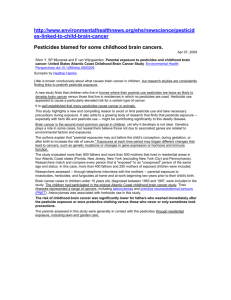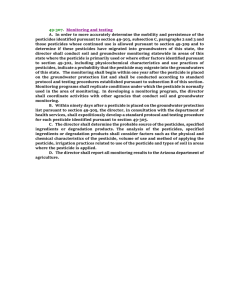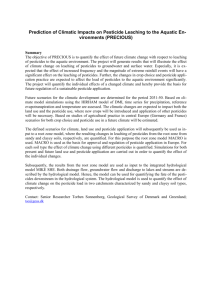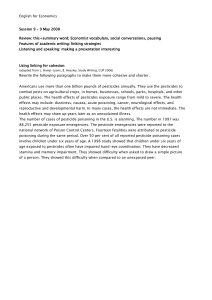PESTICIDE MANAGEMENT PROGRAM
advertisement
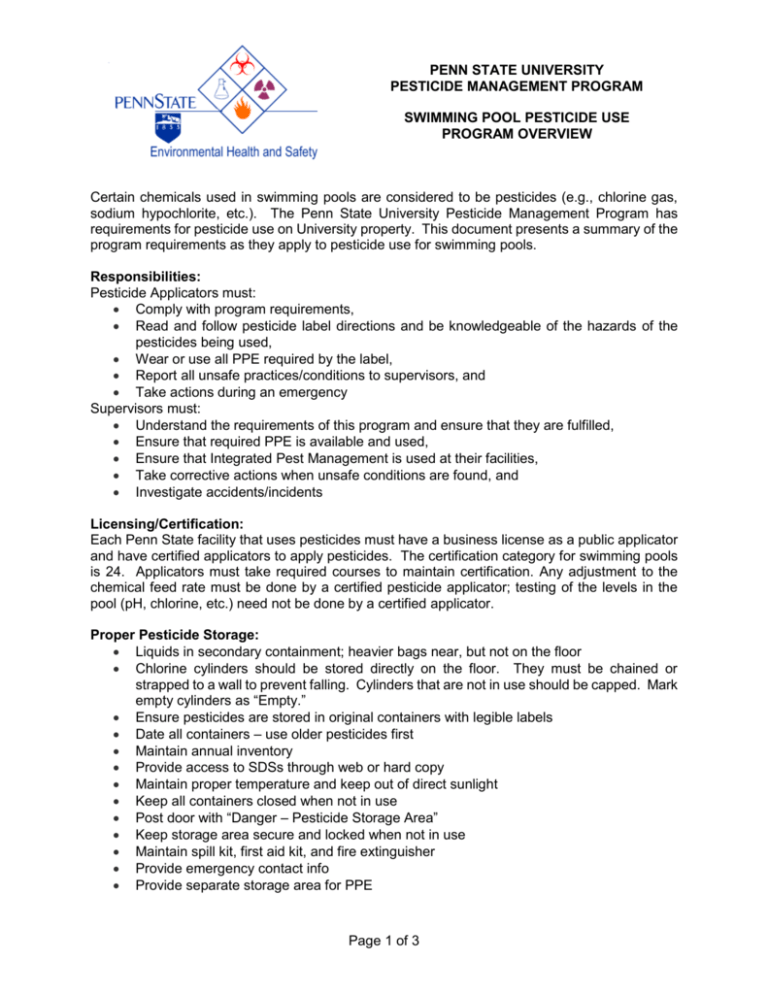
PENN STATE UNIVERSITY PESTICIDE MANAGEMENT PROGRAM SWIMMING POOL PESTICIDE USE PROGRAM OVERVIEW Certain chemicals used in swimming pools are considered to be pesticides (e.g., chlorine gas, sodium hypochlorite, etc.). The Penn State University Pesticide Management Program has requirements for pesticide use on University property. This document presents a summary of the program requirements as they apply to pesticide use for swimming pools. Responsibilities: Pesticide Applicators must: Comply with program requirements, Read and follow pesticide label directions and be knowledgeable of the hazards of the pesticides being used, Wear or use all PPE required by the label, Report all unsafe practices/conditions to supervisors, and Take actions during an emergency Supervisors must: Understand the requirements of this program and ensure that they are fulfilled, Ensure that required PPE is available and used, Ensure that Integrated Pest Management is used at their facilities, Take corrective actions when unsafe conditions are found, and Investigate accidents/incidents Licensing/Certification: Each Penn State facility that uses pesticides must have a business license as a public applicator and have certified applicators to apply pesticides. The certification category for swimming pools is 24. Applicators must take required courses to maintain certification. Any adjustment to the chemical feed rate must be done by a certified pesticide applicator; testing of the levels in the pool (pH, chlorine, etc.) need not be done by a certified applicator. Proper Pesticide Storage: Liquids in secondary containment; heavier bags near, but not on the floor Chlorine cylinders should be stored directly on the floor. They must be chained or strapped to a wall to prevent falling. Cylinders that are not in use should be capped. Mark empty cylinders as “Empty.” Ensure pesticides are stored in original containers with legible labels Date all containers – use older pesticides first Maintain annual inventory Provide access to SDSs through web or hard copy Maintain proper temperature and keep out of direct sunlight Keep all containers closed when not in use Post door with “Danger – Pesticide Storage Area” Keep storage area secure and locked when not in use Maintain spill kit, first aid kit, and fire extinguisher Provide emergency contact info Provide separate storage area for PPE Page 1 of 3 Pesticide Handling and Use: When mixing pool pesticides, never add water to pesticide chemicals – always add chemicals into water Do not add different chemicals to the pool over one another without giving the previous chemical time to disperse. Perform mixing in a location where spills can be cleaned up (such as on concrete) or vary the locations if doing this at the application site so that pesticides from small spills do not build up in the area. If spills occur, clean them up. Ensure that decontamination supplies are available (see below). Properly rinse all pesticide application equipment and spray/dump the rinsate out in an appropriate labelled location, such as into the pool rather than on the ground. Use Integrated Pest Management. The label is the law – follow all PPE and other label requirements. Check PPE requirements to chemical resistance chart to ensure the correct material is used for the PPE. If a respirator is required to be worn, be in the EHS Respiratory Protection Program. Decontamination Supplies: Decontamination supplies must be present at the pesticide mixing site, within ¼ mile of the application site, and at the location where applicators remove their PPE. The following supplies are required (per applicator): At least 3 gallons of water for washing, Soap and single-use towels, One pint of eyeflush (eyeflush required at application site only when label requires eye protection and must be immediately available), and Clean clothes (e.g., one-size coveralls). Pesticide Application Records: Date of the application and for a pesticide requiring a reentry time, the time completed, (Application records require that the start time and completion time of the application be recorded. For swimming pool pesticides such as chlorine gas or materials that come in carboys which have continuous application, the time the application begins is when the particular cylinder or carboy is connected to the chlorination system and the end time is when it is emptied or additional application is made. For manual applications, the start and completion time will be close to the same.) Location and address of application site and identification of the application site including specific area, Brand name and formulation used, and dosage rate, Name of applicator and registration number of each person making or supervising the application, and EPA registration number Disposal: Dispose unneeded pesticides through PDA’s CHEMSWEEP or through EHS Chemical and Chemical Waste Management Program. Pesticide Transportation: Never transport pesticides in the same compartment of the vehicle as people. An open truck or pickup truck is preferred with the load secured to prevent containers from shifting. If using an Page 2 of 3 open vehicle to transport pesticides, never leave it unattended. Bring a small spill kit and place liquid pesticides in secondary containment. Safety and Emergency Procedures: Preplan for emergencies (see manual for requirements). Prepare the “Vital Building Information” if required. Pesticide Spills and Releases: For releases of chlorine gas, follow the procedures established for your facility. For all other pesticide spills/releases: Identify problem Protect yourself (PPE) Stop the source of the spill or release Call 911 if an emergency release Contain the spill Recover the spilled material and absorbent Properly dispose of material Call EHS as soon as possible Incident/Accident Documentation and Investigation: Document and investigate all incidents/accidents within one week’s time, and take corrective measures if needed. Communicate findings to the work group. Documentation and Recordkeeping: Current business license and applicator certifications Records of pesticide applications (3 yrs) Annual Inventory Annual self-audit of program implementation – perform annually and submit to EHS by January 31st Refer to the Penn State University Pesticide Management Program Manual at www.ehs.psu.edu for detailed information on these topics. Page 3 of 3





